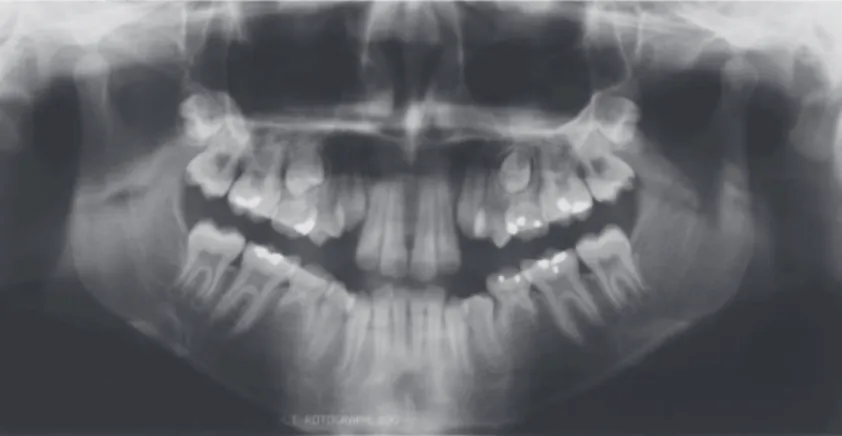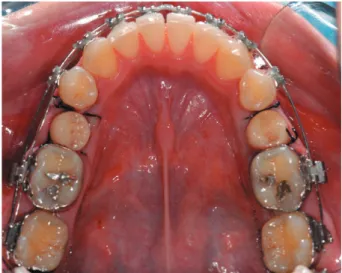A multidisciplinary approach for the management
of hypodontia: case report
Accácio Lins do VALLE1, Fabio C LORENZONI2; Leandro Moura MARTINS3, Caio Vinícius Martins do VALLE4, José
Fernando Castanha HENRIQUES5, Ana Lúcia Pompéia Fraga de ALMEIDA1, Luiz Fernando PEGORARO1
1- DDS, MS, PhD, Professor, Department of Prosthodontics, Bauru Dental School, University of São Paulo, Bauru, SP, Brazil. 2- DDS, MS, PhD student, Department of Prosthodontics, Bauru School of Dentistry, University of São Paulo, Bauru, SP, Brazil. 3- DDS, MS, PhD student, Assistant Professor, Dental School, Federal University of Amazonas, Manaus, AM, Brazil.
4- DDS, MS, MSc in Orthodontics, Bauru School of Dentistry, University of São Paulo, Bauru, SP, Brazil.
5- DDS, MS, PhD, Professor, Department of Pediatric Dentistry, Orthodontics and Community Health, Bauru School of Dentistry, University of São Paulo, Bauru, SP, Brazil.
Corresponding address: Fabio Cesar Lorenzoni - Faculdade de Odontologia de Bauru - USP - Departamento de Prótese - Alameda Dr. Octávio Pinheiro Brisolla, 9-75 - Bauru, SP - Brasil - 17012-901 - Phone: +55-14-3235-8000 - e-mail: fcesarlorenzoni@yahoo.com.br
Received: June 22, 2010 - Accepted: September 23, 2010
ABSTRACT
H
ypodontia is the congenital absence of one or more teeth and may affect permanent teeth. Several options are indicated to treat hypodontia, including the maintenance most important requirement for the ideal treatment of hypodontia. This paper describes a multidisciplinary treatment plan for congenitally missing permanent mandibular second premolars involving orthodontics, implantology and prosthodontic specialties.Key words: Hypodontia. Dental implants. Dental prosthesis design.
INTRODUCTION
The congenital absence of teeth can seriously affect a young person, both physically and is located in the anterior region of the mouth. Hypodontia is the congenital absence of teeth and
21. In addition, hypodontia of
permanent teeth is fairly common in contemporary populations11 and is the most common human
or symptoms of developmental disorders7,17,22.
Both genetic4,9 and environmental2,10 components
are involved in the etiology of hypodontia3, and
several genetic and syndromic conditions are
19;
nonetheless, congenitally missing teeth are commonly found in healthy people17,22.
The prevalence of hypodontia ranges from 1% in African Negroes and Australian aborigines to 30% in Japanese people21
subjects have reported higher frequencies of hypodontia among females (a female-to-male ratio of approximately 3:2)11. The third molars are the
most frequently missing teeth, but they do not premolars (2.8%), maxillary lateral incisors (1.6%), and maxillary second premolars and mandibular incisors (0.23%-0.08%)5 are the most frequently
missing teeth that require some type of treatment. Hypodontia usually requires extensive and complex treatments, ranging from single restorations lifelong maintenance12. Several treatment solutions
have been presented in the dental literature1,16,20,23.
In broad terms, the necessary treatment depends on the pattern of tooth absence, the amount of residual spacing, the presence of malocclusion and patient attitudes. One of the key factors for the
dental practitioner, pediatric dentist, orthodontist, ! to achieve an optimal outcome for the patient21.
of the association of orthodontic, implantology, and prosthetic specialties.
CASE REPORT
"#$& & ' second molars in position for space maintenance. Hypodontia had been previously diagnosed by the *# referred to the Oral Rehabilitation Clinic (FOB/USP) for extraction of those teeth and rehabilitation of the area. Analyses of the occlusal condition revealed the presence of both canine and protrusive guidance achieved by orthodontic therapy and that * + < any systemic or genetic disorder that could be
= '! root resorption in the primary teeth. Considering demonstrated that the patient had reached physical maturity, the bone availability, the absence of medical contraindications, and the patient consent, the treatment comprised the extraction of primary teeth and placement of immediate load implants. > the anatomy of the mandibular second premolar ' ' <
to reduce the mesiodistal distance by orthodontic therapy before implant placement. To plan the prosthetic space and at the same time to guide the orthodontic movement, the occlusal surfaces the mesiodistal dimension of a mandibular second *? > premolars (Figure 4). This step of prosthetic of the orthodontic treatment.
After the planned space closure (Figure 5), the ! ! ! @# placed (Master Porous Grip, Conexão Sistemas de =EK =KL Q * V < W (Conexão Sistemas de Implante) and placed at a > ?+ X < YZ Temp; 3M ESPE, St. Paul, MN, USA) and maintained in infra-occlusion for 4 months. During this period, retention of the orthodontically moved mandibular < acceptable after clinical (absence of pain, infection, mobility, or any other signal of pathology into the soft tissues) and radiographic (no signs of periimplant radiolucency) examinations.
"W 'Q > \® and Optosil Xantopren®;
Figure 1- Preorthodontic panoramic radiograph
Heraeus Kulzer GmbH & Co. KG, Germany). The & & ionomer cement (Relay X Luting 2; 3M ESPE). The V months during a 2-year period.
< ' w especially during the planning of the prosthetic *$<+& & up revealed maintenance of orthodontic treatment, Figure 3- Occlusal view of the mandibular primary teeth
showing the delimitation mark for the proximal reduction
Figure 4- Occlusal view showing the distal space after cementation of the provisional crown
Figure 5- Occlusal view after the planned space closure between the molars and the provisional crowns
Figure 6- Occlusal view of the provisional crowns after placement of the immediate load implants
Figure 7- Final occlusal aspect after cementation of metal-ceramic crowns of the mandibular right and left second premolars
occlusal plane and oral hygiene, esthetics (Figures 8a and 8b), and the stability of the bone level *{X loosening, and loss of retention) and/or biological
DISCUSSION
< permanent teeth is related to treatment success14.
' often performed only after eruption of all permanent teeth or completion of orthodontic treatment. The oral patient’s hygiene status and socioeconomic should also be considered6.
Multidisciplinary treatment is usually initiated upon the diagnosis of hypodontia, often by the pediatric dentist or general practitioner. The main contribution of these professionals is the prevention of carious lesions and maintenance of the primary teeth in the oral cavity for space maintenance and preservation of alveolar bone for future implant therapy6. Orthodontic treatment
for later rehabilitation8. If the primary teeth had
not been maintained in the present case, the ' dimensions of mandibular second premolars. The greatest challenge in the treatment of hypodontia depends on the severity of the hypodontia6. The
treatment options available for these cases are the maintenance of the primary teeth; orthodontic '! dental implants; or orthodontic space redistribution to facilitate the prosthetic treatment13.
Maintenance of the primary teeth should be considered if root resorption has not affected their stability24. When extraction of the primary
teeth is indicated, orthodontic treatment should be performed to prevent migration of the adjacent
> space for prosthetic rehabilitation. In the present case, besides the maintenance of the primary teeth throughout the orthodontic treatment, the completely closed, the Class I angle could not have been achieved, possibly causing occlusal and facial
alterations14
> ' molars or second premolars.
< this procedure is predictable, stable and provides excellent esthetic results18. Other treatment
'! may cause biological damage due to the need to reduce the intact tooth structure; in young patients, the risk of pulp damage is high due to the large volume of the pulp chamber8,15. When
skeleton should be considered14, and consecutive
cephalometric analyses should be performed to < patient; thus, restoration of the prosthetic space
< hypodontia may be complex due to the limitations caused by the reduced bone thickness8,15, impairing
CONCLUSION
The successful management of hypodontia in this } endosseous implants to replace the missing teeth, enhancing the esthetics and function.
REFERENCES
#&"LY QQ}~} using implants and all-ceramic restorations: a clinical report. J Prosthet Dent. 2006;95(3):186-9.
+&L} Am J Orthod Dentofacial Orthop. 1971;60:165-74.
3- Brook AH. A unifying aetiological explanation for anomalies of human tooth number and size. Arch Oral Biol. 1984;29:373-8. @& LQ X ~ W ' numeric anomalies of dentition. Birth Defects Orig Artic Ser. 1983;19:95-106.
5- Cameron J, Sampson WJ. Hypodontia of the permanent dentition. Case reports. Aust Dent J. 1996;41(1):1-5.
6- Dhanrajani PJ. Hypodontia: etiology, clinical features, and management. Quintessence Int. 2002;33(4):294-302.
7- Egermark-Eriksson I, Lind V. Congenital numerical variation in the permanent dentition. D. Sex distribution of hypodontia and hyperodontia. Odontol Revy. 1971;22(3):309-15.
8- Forgie AH, Thind BS, Larmour CJ, Mossey PA, Stirrups DR. Management of hypodontia: restorative considerations. Part III. Quintessence Int. 2005;36(6):437-45.
9- Grahnen H. Hypodontia in the permanent dentition. A clinical and genetical investigation. Odontol Revy. 1956;7(3):1-100. 10- Gravely JF,Johnson DB. Variation in the expression of Q K Y 1971;21:212-22.
11- Harris EF, Clark LL. Hypodontia: an epidemiologic study of " "\ \ 2008;134(6):761-7.
#+&"L"< hypodontia. J Oral Rehabil. 1980;7(4):289-98.
13- Hobson RS, Carter NE, Gillgrass TJ, Jepson NJ, Meechan JG, Nohl F, et al. The interdisciplinary management of hypodontia: dental practitioner. Br Dent J. 2003;194(9):479-82.
14- Holst S, Geiselhoringer H, Nkenke E, Blatz MB, Holst AI. Update & Quintessence Int. 2008;39(10):797-802.
15- Jepson NJ, Nohl FS, Carter NE, Gillgrass TJ, Meechan JG, Hobson RS, et al. The interdisciplinary management of hypodontia: restorative dentistry. Br Dent J. 2003;194(6):299-304.
16- Kinzer GA, Kokich VO Jr. Managing congenitally missing lateral incisors. Part II: tooth-supported restorations. J Esthet Restor Dent. 2005;17(2):76-84.
17- Larmour CJ, Mossey PA, Thind BS, Forgie AH, Stirrups DR. & K I. Quintessence Int. 2005;36(4):263-70.
18- Lazzara R, Siddiqui AA, Binon P, Feldman SA, Weiner R, Phillips R, et al. Retrospective multicenter analysis of 3i endosseous dental '& W\ Y 1996;7(1):73-83.
19- Lucas J. The syndromic tooth--the aetiology, prevalence, syndromes. Ann R Australas Coll Dent Surg. 2000;15:211-7. 20- Murdock S, Lee JY, Guckes A, Wright JT. A costs analysis of dental treatment for ectodermal dysplasia. J Am Dent Assoc. 2005;136(9):1273-6.
21- Nunn JH, Carter NE, Gillgrass TJ, Hobson RS, Jepson NJ, Meechan JG, et al. The interdisciplinary management of hypodontia: background and role of paediatric dentistry. Br Dent J. 2003;194(5):245-51.
22- Polder BJ, Van't Hof MA, Van der Linden FP, Kuijpers-Jagtman AM. A meta-analysis of the prevalence of dental agenesis of permanent teeth. Community Dent Oral Epidemiol. 2004;32(3):217-26.

